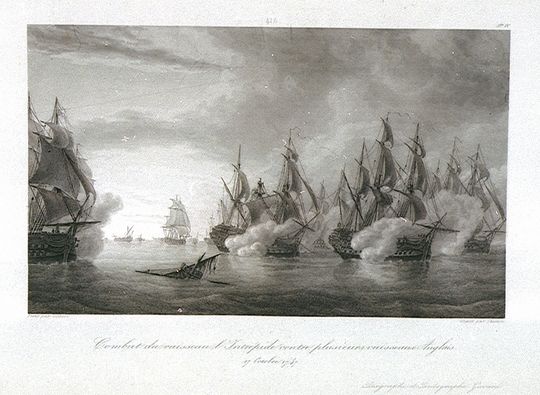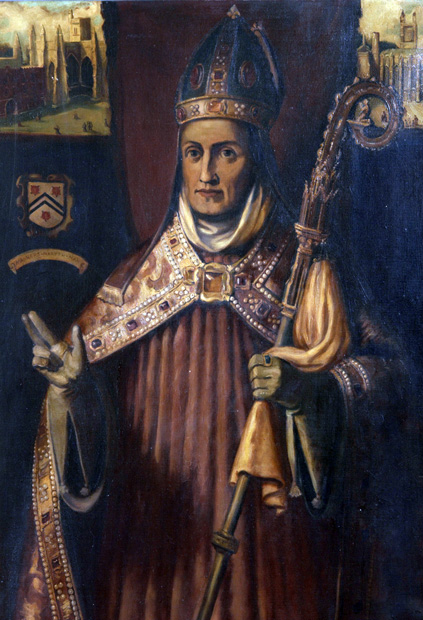|
Old Alresford House
Old Alresford House is an 18th-century Georgian country house in Old Alresford, Hampshire, England. It is a Grade II* listed building. It was built between 1749 and 1751 for George Brydges Rodney, 1st Baron Rodney, Admiral Lord Rodney on a gently sloping south facing site between the village churchyard and Alresford Pond, paid for by the riches accrued in a successful naval career fighting the French in the Caribbean. The house is constructed of brick with Bath stone dressings and slated roofs in 3 storeys and a basement. It has a 7-bay frontage with the central 3 bays slightly projecting. There are single bay flanking wings at each end with single storey service wings on both sides at the front forming a courtyard. Rodney purchased Alresford Pond in 1755 before commissioning Richard Woods to create the park in 1764, which is itself now Grade II listed. History Old Alresford (pronounced Allsford) had belonged to the Bishop of Winchester for over a thousand years. During the m ... [...More Info...] [...Related Items...] OR: [Wikipedia] [Google] [Baidu] |
English Country House
image:Blenheim - Blenheim Palace - 20210417125239.jpg, 300px, Blenheim Palace - Oxfordshire An English country house is a large house or mansion in the English countryside. Such houses were often owned by individuals who also owned a Townhouse (Great Britain), town house. This allowed them to spend time in the country and in the city—hence, for these people, the term distinguished between town and country. However, the term also encompasses houses that were, and often still are, the full-time residence for the landed gentry who dominated rural Britain until the Reform Act 1832. Frequently, the formal business of the Historic counties of England, counties was transacted in these country houses, having functional antecedents in manor houses. With large numbers of indoor and outdoor staff, country houses were important as places of employment for many rural communities. In turn, until the Great Depression of British Agriculture, agricultural depressions of the 1870s, the est ... [...More Info...] [...Related Items...] OR: [Wikipedia] [Google] [Baidu] |
Georgian Architecture
Georgian architecture is the name given in most English-speaking countries to the set of architectural styles current between 1714 and 1830. It is named after the first four Monarchy of the United Kingdom, British monarchs of the House of Hanover, George I of Great Britain, George I, George II of Great Britain, George II, George III, and George IV, who reigned in continuous succession from August 1714 to June 1830. The Georgian cities of the British Isles were Edinburgh, Bath, Somerset, Bath, pre-independence Georgian Dublin, Dublin, and London, and to a lesser extent York and Bristol. The style was revived in the late 19th century in the United States as Colonial Revival architecture and in the early 20th century in Great Britain as Neo-Georgian architecture; in both it is also called Georgian Revival architecture. In the United States, the term ''Georgian'' is generally used to describe all buildings from the period, regardless of style; in Britain it is generally restricte ... [...More Info...] [...Related Items...] OR: [Wikipedia] [Google] [Baidu] |
Old Alresford
Old Alresford ( or ) is a village and civil parish in Hampshire, England. It is north of the town of New Alresford, northeast of the city of Winchester, and south-west of the town of Alton. Alresford Pond is a large water feature south of Old Alresford and north of New Alresford. Etymology Old Alresford is first mentioned in an Anglo-Saxon Charter of 701 as ''Alresforda''. Its name derives from the Old English ''Alor'' and ''Ford'' and means the ford at the alder tree. History St Mary the Virgin parish church is a brick building dating from the 1750s. The naval hero George Brydges Rodney, 1st Baron Rodney, is buried in the church. His family seat, Old Alresford House, is next to the church. Also in the churchyard is the mausoleum of C. F. G. R. Schwerdt, an art collector, who died in 1939. In 1851, George Sumner, son of Charles Richard Sumner (Bishop of Winchester), became rector of the parish. There his wife, Mary Sumner, started the Mothers' Union, now a g ... [...More Info...] [...Related Items...] OR: [Wikipedia] [Google] [Baidu] |
Grade II* Listed
In the United Kingdom, a listed building is a structure of particular architectural or historic interest deserving of special protection. Such buildings are placed on one of the four statutory lists maintained by Historic England in England, Historic Environment Scotland in Scotland, in Wales, and the Historic Environment Division of the Department for Communities in Northern Ireland. The classification schemes differ between England and Wales, Scotland, and Northern Ireland (see sections below). The term has also been used in the Republic of Ireland, where buildings are protected under the Planning and Development Act 2000, although the statutory term in Ireland is " protected structure". A listed building may not be demolished, extended, or altered without permission from the local planning authority, which typically consults the relevant central government agency. In England and Wales, a national amenity society must be notified of any work to be done on a listed building ... [...More Info...] [...Related Items...] OR: [Wikipedia] [Google] [Baidu] |
George Brydges Rodney, 1st Baron Rodney
Admiral George Brydges Rodney, 1st Baron Rodney, KB ( bap. 13 February 1718 – 24 May 1792), was a Royal Navy officer, politician and colonial administrator. He is best known for his commands in the American War of Independence, particularly his victory over the French at the Battle of the Saintes in 1782. It is often claimed that he was the commander to have pioneered the tactic of breaking the line. Rodney came from a distinguished but poor background, and went to sea at the age of fourteen. His first major action was the Second Battle of Cape Finisterre in 1747. He made a large amount of prize money during the 1740s, allowing him to purchase a large country estate and a seat in the House of Commons of Great Britain. During the Seven Years' War, Rodney was involved in a number of amphibious operations such as the raids on Rochefort and Le Havre and the Siege of Louisbourg. He became well known for his role in the capture of Martinique in 1762. Following the Peace of ... [...More Info...] [...Related Items...] OR: [Wikipedia] [Google] [Baidu] |
Bishop Of Winchester
The Bishop of Winchester is the diocesan bishop of the Diocese of Winchester in the Church of England. The bishop's seat (''cathedra'') is at Winchester Cathedral in Hampshire. The Bishop of Winchester has always held ''ex officio'' the office of Prelate of the Order of the Garter, Most Noble Order of the Garter since its foundation in 1348. except during the period of the Commonwealth of England, Commonwealth until the Stuart Restoration, Restoration of the Monarchy. Bishops of Winchester also often held the positions of Lord Treasurer and Lord Chancellor ''ex officio''. During the Middle Ages, the Diocese of Winchester was one of the wealthiest English sees, and its bishops have included a number of politically prominent Englishmen, notably the 9th century Saint Swithun and medieval magnates including William of Wykeham and Henry of Blois. The Bishop of Winchester is appointed by the Crown, and is one of five Church of England bishops who sit ''ex officio'' among the 26 Lo ... [...More Info...] [...Related Items...] OR: [Wikipedia] [Google] [Baidu] |
Godfrey De Luci
Godfrey de Lucy or Luci (d. September 1204) was a medieval Bishop of Winchester. Life Godfrey de Lucy was the son of Richard de LucyBritish History Online Archdeacons of Richmond accessed on 24 April 2024 and his wife Rohese de Clare or de Boulogne. He had an elder brother Geoffrey, and three sisters, Maud, Alice, and Aveline.Turner "Exercise of the King's Will" ''Albion'' p. 400 Godfrey was dean of St. Martin le Grand in London before being appointed Archdeacon of Derby in the |
George Rodney, 2nd Baron Rodney
Lieutenant-Colonel George Rodney, 2nd Baron Rodney (25 December 1753 – 2 January 1802), was a British soldier and politician. Rodney was the eldest son of Admiral George Rodney, 1st Baron Rodney, by his first wife Lady Jane Compton, daughter of the Honourable Charles Compton (MP), Charles Compton. His mother died when he was three years old. Rodney was a Captain (British Army and Royal Marines), captain in the 3rd Foot Guards and a lieutenant-colonel in the British Army. In 1780 he was returned to Parliament for Northampton (UK Parliament constituency), Northampton, a seat he held until 1784. In 1792 he entered the House of Lords on the death of his father and inherited Old Alresford House, built by his father at Old Alresford, Hampshire. Lord Rodney married Anne Harley, daughter of the Honourable Thomas Harley (politician, born 1730), Thomas Harley, in 1781. They had nine sons and one daughter. He died in January 1802, aged 48, and was succeeded by his eldest son, George Rod ... [...More Info...] [...Related Items...] OR: [Wikipedia] [Google] [Baidu] |
Gerald Maxwell
Gerald Joseph Constable Maxwell (8 September 1895 – 18 December 1959) was a British First World War flying ace credited with twenty-six aerial victories. Background Maxwell was born in Beauly near Inverness, Scotland, to the Honourable Bernard Constable-Maxwell (son of William Constable-Maxwell, 10th Lord Herries of Terregles) and the Honourable Alice Fraser (daughter of Simon Fraser, 13th Lord Lovat), both of whom were scions of notable Scottish recusant families. He was educated at Downside School. World War I service Maxwell was commissioned in the Lovat Scouts on 4 August 1914 and fought at Gallipoli. He then served in Egypt before returning to the UK, where he transferred to the Royal Flying Corps in September 1916. Maxwell completed final pilot training at Central Flying School, Upavon and joined No. 56 Squadron in London Colney in March 1917. He was attached to 'A' Flight, commanded by Captain Albert Ball, flying SE5 aircraft. In April 1917, Maxwell's squadron w ... [...More Info...] [...Related Items...] OR: [Wikipedia] [Google] [Baidu] |
Country Houses In Hampshire
A country is a distinct part of the world, such as a state, nation, or other political entity. When referring to a specific polity, the term "country" may refer to a sovereign state, state with limited recognition, constituent country, or dependent territory. Most sovereign states, but not all countries, are members of the United Nations. There is no universal agreement on the number of "countries" in the world, since several states have disputed sovereignty status or limited recognition, and a number of non-sovereign entities are commonly considered countries. The definition and usage of the word "country" are flexible and have changed over time. ''The Economist'' wrote in 2010 that "any attempt to find a clear definition of a country soon runs into a thicket of exceptions and anomalies." Areas much smaller than a political entity may be referred to as a "country", such as the West Country in England, "big sky country" (used in various contexts of the American West), "coal ... [...More Info...] [...Related Items...] OR: [Wikipedia] [Google] [Baidu] |






